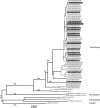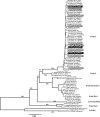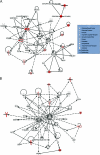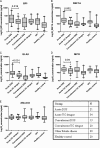The early whole-blood transcriptional signature of dengue virus and features associated with progression to dengue shock syndrome in Vietnamese children and young adults
- PMID: 20943967
- PMCID: PMC3004338
- DOI: 10.1128/JVI.01224-10
The early whole-blood transcriptional signature of dengue virus and features associated with progression to dengue shock syndrome in Vietnamese children and young adults
Abstract
Dengue is a pantropic public health problem. In children, dengue shock syndrome (DSS) is the most common life-threatening complication. The ability to predict which patients may develop DSS may improve triage and treatment. To this end, we conducted a nested case-control comparison of the early host transcriptional features in 24 DSS patients and 56 sex-, age-, and virus serotype-matched uncomplicated (UC) dengue patients. In the first instance, we defined the "early dengue" profile. The transcriptional signature in acute rather than convalescent samples (≤72 h post-illness onset) was defined by an overabundance of interferon-inducible transcripts (31% of the 551 overabundant transcripts) and canonical gene ontology terms that included the following: response to virus, immune response, innate immune response, and inflammatory response. Pathway and network analyses identified STAT1, STAT2, STAT3, IRF7, IRF9, IRF1, CEBPB, and SP1 as key transcriptional factors mediating the early response. Strikingly, the only difference in the transcriptional signatures of early DSS and UC dengue cases was the greater abundance of several neutrophil-associated transcripts in patients who progressed to DSS, a finding supported by higher plasma concentrations of several canonical proteins associated with neutrophil degranulation (bactericidal/permeability-increasing protein [BPI], elastase 2 [ELA2], and defensin 1 alpha [DEF1A]). Elevated levels of neutrophil-associated transcripts were independent of the neutrophil count and also of the genotype of the infecting virus, as genome-length sequences of dengue virus serotype 1 (DENV-1) (n = 15) and DENV-2 (n = 3) sampled from DSS patients were phylogenetically indistinguishable from those sampled from uncomplicated dengue patients (32 DENV-1 and 9 DENV-2 sequences). Collectively, these data suggest a hitherto unrecognized association between neutrophil activation, pathogenesis, and the development of DSS and point to future strategies for guiding prognosis.
Figures





Similar articles
-
Patterns of host genome-wide gene transcript abundance in the peripheral blood of patients with acute dengue hemorrhagic fever.J Infect Dis. 2007 Apr 15;195(8):1097-107. doi: 10.1086/512162. Epub 2007 Mar 5. J Infect Dis. 2007. PMID: 17357045 Free PMC article.
-
Patterns of gene transcript abundance in the blood of children with severe or uncomplicated dengue highlight differences in disease evolution and host response to dengue virus infection.J Infect Dis. 2009 Feb 15;199(4):537-546. doi: 10.1086/596507. J Infect Dis. 2009. PMID: 19138155 Free PMC article.
-
Genome-wide expression profiling deciphers host responses altered during dengue shock syndrome and reveals the role of innate immunity in severe dengue.PLoS One. 2010 Jul 20;5(7):e11671. doi: 10.1371/journal.pone.0011671. PLoS One. 2010. PMID: 20652028 Free PMC article.
-
Dengue virus non-structural protein 1: a pathogenic factor, therapeutic target, and vaccine candidate.J Biomed Sci. 2018 Jul 24;25(1):58. doi: 10.1186/s12929-018-0462-0. J Biomed Sci. 2018. PMID: 30037331 Free PMC article. Review.
-
Re-evaluation of the pathogenic roles of nonstructural protein 1 and its antibodies during dengue virus infection.J Biomed Sci. 2013 Jun 27;20(1):42. doi: 10.1186/1423-0127-20-42. J Biomed Sci. 2013. PMID: 23806052 Free PMC article. Review.
Cited by
-
Guanylate-binding protein 1 participates in cellular antiviral response to dengue virus.Virol J. 2012 Nov 27;9:292. doi: 10.1186/1743-422X-9-292. Virol J. 2012. PMID: 23186538 Free PMC article.
-
Neutrophil Activation and Early Features of NET Formation Are Associated With Dengue Virus Infection in Human.Front Immunol. 2019 Jan 11;9:3007. doi: 10.3389/fimmu.2018.03007. eCollection 2018. Front Immunol. 2019. PMID: 30687301 Free PMC article.
-
A 20-Gene Set Predictive of Progression to Severe Dengue.Cell Rep. 2019 Jan 29;26(5):1104-1111.e4. doi: 10.1016/j.celrep.2019.01.033. Cell Rep. 2019. PMID: 30699342 Free PMC article.
-
DHIM supporting immunologic investigations and the identification of immune correlates of protection.J Infect Dis. 2014 Jun 15;209 Suppl 2(Suppl 2):S61-5. doi: 10.1093/infdis/jiu111. J Infect Dis. 2014. PMID: 24872398 Free PMC article.
-
miR-223 inhibits dengue virus replication by negatively regulating the microtubule-destabilizing protein STMN1 in EAhy926 cells.Microbes Infect. 2014 Nov;16(11):911-22. doi: 10.1016/j.micinf.2014.08.011. Epub 2014 Aug 30. Microbes Infect. 2014. PMID: 25181337 Free PMC article.
References
-
- Ashburner, M., C. A. Ball, J. A. Blake, D. Botstein, H. Butler, J. M. Cherry, A. P. Davis, K. Dolinski, S. S. Dwight, J. T. Eppig, M. A. Harris, D. P. Hill, L. Issel-Tarver, A. Kasarskis, S. Lewis, J. C. Matese, J. E. Richardson, M. Ringwald, G. M. Rubin, and G. Sherlock. 2000. Gene ontology: tool for the unification of biology. The Gene Ontology Consortium. Nat. Genet. 25:25-29. - PMC - PubMed
-
- Benjamini, Y., and Y. Hochberg. 1995. Controlling the false discovery rate: a practical and powerful approach to multiple Testing. J. R. Stat. Soc. Series B Stat. Methodol. 57:289-300.
-
- Bethell, D. B., K. Flobbe, X. T. Cao, N. P. Day, T. P. Pham, W. A. Buurman, M. J. Cardosa, N. J. White, and D. Kwiatkowski. 1998. Pathophysiologic and prognostic role of cytokines in dengue hemorrhagic fever. J. Infect. Dis. 177:778-782. - PubMed
-
- Bethell, D. B., J. Gamble, P. L. Pham, M. D. Nguyen, T. H. Tran, T. H. Ha, T. N. Tran, T. H. Dong, I. B. Gartside, N. J. White, and N. P. Day. 2001. Noninvasive measurement of microvascular leakage in patients with dengue hemorrhagic fever. Clin. Infect. Dis. 32:243-253. - PubMed
Publication types
MeSH terms
Substances
Grants and funding
LinkOut - more resources
Full Text Sources
Other Literature Sources
Molecular Biology Databases
Research Materials
Miscellaneous

